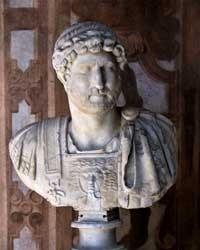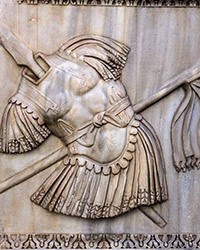
Crouching Venus, fragment, Museo Nazionale Romano – Palazzo Massimo alle Terme

Crouching Venus, roman copy of greek sculpture, 2nd century AD,Museo Nazionale Romano – Palazzo Massimo alle Terme

Crouching Venus, fragment, Museo Nazionale Romano – Palazzo Massimo alle Terme

Crouching Venus, Museo Nazionale Romano – Palazzo Massimo alle Terme, pic. Wikipedia

Crouching Venus, Museo Nazionale Romano - Palazzo Altemps

Aphrodite and Eros, Museo Nazionale Romano - Palazzo Altemps

Crouching Venus, Musei Vaticani

Crouching Venus, Musée du Louvre, Paris, pic. Jastrow

Crouching Aphrodite, the so-called Lely's Vernus, a Roman copy of a Greek sculpture by Dooidales, British Museum, London, pic. Wikipedia

Aphrodite and Eros, Hermitage Museum, Saint Petersburg, pic. Wkipedia
When wandering the museum rooms of the Roman Palazzo Massimo we reach this place, we can be under the impression that we are surrounded by ancient gods and heroes, and each of them wants to attract our attention, stop us, and tell us their own story. We find ourselves among snow-white statues, which like actors play roles that only they are aware of. We can look at them from all sides, and admire their beautiful bodies and elegant gestures captured in stone. It is here that we will see the crouching Aphrodite as if surprised by our coming. Her face is only partially preserved. She is also missing her arms, and it is this lack of arms that arouses our imagination and causes the sculpture to appear as something thoroughly modern.
When wandering the museum rooms of the Roman Palazzo Massimo we reach this place, we can be under the impression that we are surrounded by ancient gods and heroes, and each of them wants to attract our attention, stop us, and tell us their own story. We find ourselves among snow-white statues, which like actors play roles that only they are aware of. We can look at them from all sides, and admire their beautiful bodies and elegant gestures captured in stone. It is here that we will see the crouching Aphrodite as if surprised by our coming. Her face is only partially preserved. She is also missing her arms, and it is this lack of arms that arouses our imagination and causes the sculpture to appear as something thoroughly modern.
The preserved fragment of the face is enough to notice the parted lips of the goddess with the outline of her teeth. Her delicate breasts and one eye have been fully preserved. The torso bereft of arms, and the wrinkles visible on her stomach and side bring a slight smile to our faces. Aphrodite is shown at a moment of crouching on one knee, most likely during a bath. Were her arms and hands resting on her hips, or were they raised above her head – we can only guess, recalling other sculptures of this goddess. However, let us start at the beginning, meaning ancient Greece.
Born out of sea foam, Aphrodite was the patron goddess of love, fertility, and abundance. The Greek temples devoted to her attracted a multitude of tourists bringing her flowers, fruits, and fragrant incense, as well as bread in the shape of a phallus. Very rapidly she became a popular topic of art. Her most common and well-known representations are statues of the nude or semi-nude goddess captured in a contrapost, and the best example of such a representation is the Vatican statue of Venus from Knidos. This type of representative image started to evolve around the III century B.C. In art, this was a time of the search for more natural and genre poses bereft of the signs of refinement, and it was then that the motif of the crouching Aphrodite appeared, brushing, drying, or washing her hair, or tying her sandal.

Although she was still referred to as Aphrodite, we can have no doubts that this is a full-blooded woman, who would become one of the most popular topics of Greek art, and then of Western art. Even then (which may be surprising), to present a nude woman, the Greeks needed camouflage – and this could have been… divinity. Interestingly enough, they did not need it to show men. Nude athletes were presented without any problems, however, women were not.
The original sculpture of the crouching Venus was made, by the Bithynian (present-day northern Turkey) sculptor Doidalsas in the mid-III century B.C. The original was not preserved. In this Natural History, the Roman author Pliny the Elder mentions the fact that the ruler of Bithynia, Nicomedes I, tried to buy the famous sculpture of the nude Aphrodite made by Praxiteles from the Knidosians. However, when he did not succeed, he employed a local artist – the aforementioned Doidalsas – to create his own work, which resulted in the sculpture of the crouching Aphrodite, probably made out of bronze. The sculpture from Museo Massimo is one of its marble copies, of which many were made by the fascinated with Greek art and mythology Romans. At that time Aphrodite changed her name to Venus, and similarly to Greece, she became one of the principal goddesses of the Roman pantheon. The statue presented in the Palazzo Massimo was completed in the first half of the II century A.D., commissioned by the great enthusiast of Greek art Emperor Hadrian (117-138), and placed in the baths in his villa in Tivoli (Hadrian's Villa).

Copies of the crouching Venus, made by the Romans in great numbers, flooded the empire. Private chambers, and gardens, but above all baths were decorated with them. In their interiors, it was not so much about looking at a goddess, but more about eavesdropping on a beautiful nude, young woman. Today these statues (crouching, washing, and drying goddesses) can be found in numerous museums around the world. In Rome itself, we can find them in several places – for example in the Vatican Museums or in the collections of the Palazzo Altemps, to name but the most famous ones. None of these, despite being better preserved are as beautiful as our heroine.

Paradoxically – as was mentioned – the charm of our sculpture is due to it being badly preserved. Thanks to significant parts of the presented figure being damaged, we can only imagine her posture and gestures – we are not condemned to a single vision. With our imagination we can see a woman raising her hands – to dry her hair, squeeze the water out of it… or perhaps she is not raising her hands at all, but rather with one (right hand) she is covering her womb, and with the other, her breasts, protecting them against our gaze, similarly to the reconstructed Venus from the British Museum. It seems that in crouching, she turns her head as if she was made anxious by some noise. As if she was startled, listening. Perhaps she, similarly to the Old Testament Susanna was surprised by some elders? But then again this did not have to be a man, but her anxiety could have been caused by an animal, or some unknown noise, which interrupted her bath. The image of an unexpected meeting with something or someone introduces anxiety or perhaps fear into the body of Venus. And we are also drawn out of our careless spying by her anxiety. Spying is of course something entirely different than admiring or looking. It hides within a kind of ambiguity – the eternal human need to satisfy our curiosity is accompanied by the crossing of the border of the intimacy of the person being spied upon. The woman seems to be ashamed of her nudity, which arouses an even greater interest in the voyeur that we have become, and it fills us with the certainty that it is not the goddess of love Venus who crouches in front of us, but rather a startled, slightly scared girl, tensely listening to our steps. We, on the other hand, have been eavesdropping on her for centuries, not paying attention to her uneasiness, in fact – expecting it. That is because we know that openly exposed nudity is not exciting, however, a camouflaged, spied upon, and filled with fear nudity, certainly is.
Crouching Venus, Museo Nazionale Romano – Palazzo Massimo alle Terme































